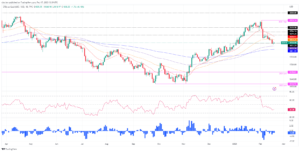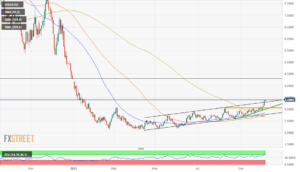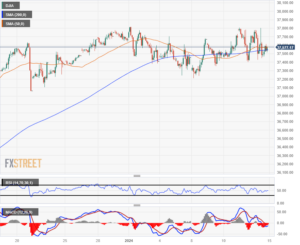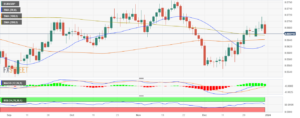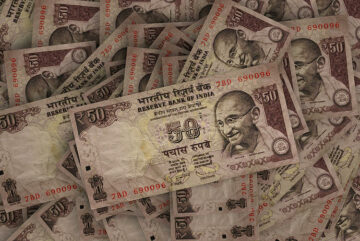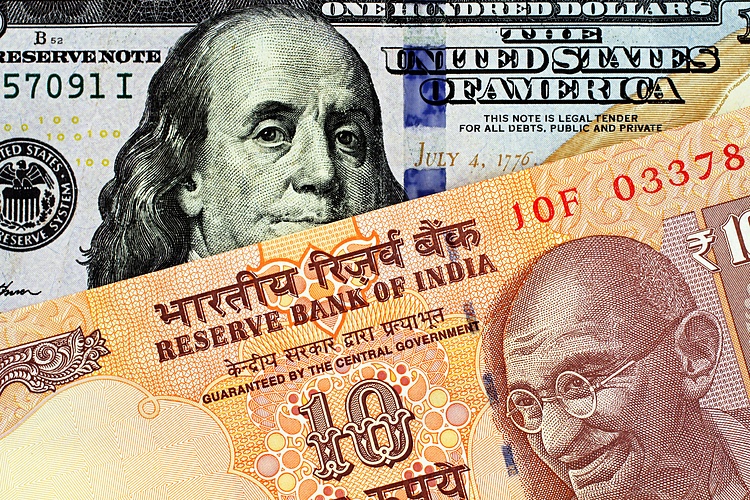
- Indian Rupee remains relatively quiet ahead of the FOMC meeting.
- The Reserve Bank of India (RBI) MPC decided to keep the rate steady at 6.50% at its December meeting.
- Investors will closely monitor the US inflation data ahead of the FOMC interest rate decision.
Indian Rupee (INR) trades flat with mild losses on Monday as traders prefer to wait on the sidelines ahead of the key US event. On Friday, the Reserve Bank of India (RBI) Monetary Policy Committee (MPC) decided to keep the interest rate unchanged at 6.50% while raising its growth forecast for the current fiscal year to 7% from 6.5% earlier. RBI’s Das said easing inflation across all components of retail inflation is one of the reasons behind the MPC’s decision to keep the repo rate unchanged.
RBI’s Das further stated that the near-term picture is clouded by risks to food inflation, which might lead to higher inflation in November and possibly December. This should be monitored for potential second-round effects.
Investors will closely monitor the US inflation data, as measured by Consumer Price Index (CPI). The attention will shift to the Federal Open Market Committee (FOMC) meeting on Tuesday and Wednesday. In the meantime, RBI could support the Indian Rupee at 83.40 as oil companies and others would buy on dips in USD/INR.
Daily Digest Market Movers: The Indian Rupee remains resilient to external shocks amid better macro data, sustainable forex reserves, and investor inflows
- The Reserve Bank of India (RBI) governor Shaktikanta Das announced the Monetary Policy Committee decided unanimously to keep the policy repo rate unchanged at 6.5% and keep the focus on the withdrawal of accommodation.
- Das highlighted the Indian economy is resilient and has momentum, as reflected in the GDP growth for the second quarter of the ongoing financial year.
- Indian retail inflation is estimated at 5.4% in FY24. RBI also projected retail inflation in Q3 of FY24 at 5.6% and 5.2% in Q4.
- The forecast growth rate for India’s GDP in FY24 is currently set at 7.0%, with growth rates forecast of 6.5% and 6.0% for the third and fourth quarters, respectively.
- India’s foreign exchange reserves increased to $604 billion as of December 1, surpassing the $600 billion mark after a gap of about four months.
- US Nonfarm Payrolls (NFP) rose by 199K from October’s increase of 150K and came in above the market expectation of 180K.
- Unemployment Rate declined to 3.7% from 3.9% in the same period, while Average Hourly Earnings remained steady at 4.0%, in line with the market expectation.
- The preliminary University of Michigan Consumer Sentiment Index for December arrived at 69.4 from 61.3 in the previous reading, the second-highest reading this year.
Technical Analysis: Indian Rupee trades flat with a slight positive bias
Indian Rupee trades flat on the day. The USD/INR pair has traded near the upper boundary of a trading range of 82.80–83.40 since September. According to the daily chart, USD/INR maintains its bullish vibes as it holds above the key 100-day Exponential Moving Average (EMA). Additionally, the 14-day Relative Strength Index (RSI) continues above the 50.0 threshold, bolstering the upward momentum.
That being said, a decisive break above the upper boundary of the trading range of 83.40 could pave the way to the next hurdle at the year-to-date (YTD) high of 83.47, followed by a round figure of 84.00. On the downside, the critical support level is seen at the 83.00 psychological round figure. A break below 83.00 will see a drop to 82.80, representing the confluence of the lower limit of the trading range and a low of September 12. The additional downside to watch is a low of August 11 at 82.60.
US Dollar price today
The table below shows the percentage change of US Dollar (USD) against listed major currencies today. US Dollar was the strongest against the Australian Dollar.
| USD | EUR | GBP | CAD | AUD | JPY | NZD | CHF | |
| USD | -0.02% | 0.07% | 0.11% | 0.31% | 0.27% | 0.09% | -0.01% | |
| EUR | 0.02% | 0.09% | 0.12% | 0.31% | 0.28% | 0.10% | 0.01% | |
| GBP | -0.06% | -0.08% | 0.03% | 0.22% | 0.20% | 0.02% | -0.08% | |
| CAD | -0.11% | -0.12% | -0.04% | 0.19% | 0.16% | -0.01% | -0.12% | |
| AUD | -0.31% | -0.33% | -0.23% | -0.19% | -0.03% | -0.20% | -0.30% | |
| JPY | -0.25% | -0.27% | -0.27% | -0.15% | 0.05% | -0.16% | -0.28% | |
| NZD | -0.09% | -0.11% | -0.02% | 0.02% | 0.22% | 0.18% | -0.10% | |
| CHF | 0.01% | 0.00% | 0.08% | 0.12% | 0.30% | 0.27% | 0.10% |
The heat map shows percentage changes of major currencies against each other. The base currency is picked from the left column, while the quote currency is picked from the top row. For example, if you pick the Euro from the left column and move along the horizontal line to the Japanese Yen, the percentage change displayed in the box will represent EUR (base)/JPY (quote).
Indian Rupee FAQs
The Indian Rupee (INR) is one of the most sensitive currencies to external factors. The price of Crude Oil (the country is highly dependent on imported Oil), the value of the US Dollar – most trade is conducted in USD – and the level of foreign investment, are all influential. Direct intervention by the Reserve Bank of India (RBI) in FX markets to keep the exchange rate stable, as well as the level of interest rates set by the RBI, are further major influencing factors on the Rupee.
The Reserve Bank of India (RBI) actively intervenes in forex markets to maintain a stable exchange rate, to help facilitate trade. In addition, the RBI tries to maintain the inflation rate at its 4% target by adjusting interest rates. Higher interest rates usually strengthen the Rupee. This is due to the role of the ‘carry trade’ in which investors borrow in countries with lower interest rates so as to place their money in countries’ offering relatively higher interest rates and profit from the difference.
Macroeconomic factors that influence the value of the Rupee include inflation, interest rates, the economic growth rate (GDP), the balance of trade, and inflows from foreign investment. A higher growth rate can lead to more overseas investment, pushing up demand for the Rupee. A less negative balance of trade will eventually lead to a stronger Rupee. Higher interest rates, especially real rates (interest rates less inflation) are also positive for the Rupee. A risk-on environment can lead to greater inflows of Foreign Direct and Indirect Investment (FDI and FII), which also benefit the Rupee.
Higher inflation, particularly, if it is comparatively higher than India’s peers, is generally negative for the currency as it reflects devaluation through oversupply. Inflation also increases the cost of exports, leading to more Rupees being sold to purchase foreign imports, which is Rupee-negative. At the same time, higher inflation usually leads to the Reserve Bank of India (RBI) raising interest rates and this can be positive for the Rupee, due to increased demand from international investors. The opposite effect is true of lower inflation.
- SEO Powered Content & PR Distribution. Get Amplified Today.
- PlatoData.Network Vertical Generative Ai. Empower Yourself. Access Here.
- PlatoAiStream. Web3 Intelligence. Knowledge Amplified. Access Here.
- PlatoESG. Carbon, CleanTech, Energy, Environment, Solar, Waste Management. Access Here.
- PlatoHealth. Biotech and Clinical Trials Intelligence. Access Here.
- Source: https://www.fxstreet.com/news/usd-inr-trades-flat-as-investors-turn-cautious-ahead-of-us-cpi-fomc-meeting-202312110338
- :has
- :is
- $UP
- 1
- 11
- 12
- 2%
- 32
- 40
- 41
- 50
- 60
- 7
- 80
- 84
- a
- About
- above
- accommodation
- According
- across
- actively
- addition
- Additional
- Additionally
- adjusting
- After
- against
- ahead
- All
- along
- also
- Amid
- analysis
- and
- Animate
- announced
- ARE
- arrived
- AS
- At
- attention
- AUGUST
- Australian
- Australian dollar
- average
- Balance
- Bank
- Bank of India
- base
- BE
- behind
- being
- below
- benefit
- Better
- Billion
- bolstering
- borrow
- Box
- Break
- Bullish
- buy
- by
- came
- CAN
- cautious
- change
- Changes
- Chart
- closely
- Column
- committee
- Companies
- comparatively
- components
- conducted
- confluence
- consumer
- consumer price index
- consumer sentiment
- content
- continues
- Cost
- could
- countries
- country
- CPI
- critical
- crude
- Crude oil
- currencies
- Currency
- Current
- Currently
- daily
- data
- day
- December
- decided
- decision
- decisive
- Demand
- dependent
- Devaluation
- difference
- Digest
- direct
- displayed
- Dollar
- downside
- Drop
- due
- each
- Earlier
- Earnings
- easing
- Economic
- Economic growth
- economy
- effect
- effects
- EMA
- ends
- Environment
- especially
- estimated
- EUR
- Euro
- Event
- eventually
- example
- exchange
- Exchange rate
- Exchange Reserves
- expanded
- expectation
- exponential
- exponential moving average
- exports
- external
- facilitate
- factors
- FAQ
- Federal
- Federal Open Market Committee
- Figure
- financial
- Fiscal
- flat
- Focus
- followed
- FOMC
- food
- For
- Forecast
- foreign
- foreign exchange
- foreign investment
- forex
- Forex markets
- four
- Fourth
- Friday
- from
- further
- FX
- FX markets
- gap
- GDP
- gdp growth
- generally
- Governor
- greater
- Growth
- help
- High
- higher
- Highlighted
- highly
- holds
- Horizontal
- HTTPS
- hurdle
- if
- imports
- in
- include
- Increase
- increased
- Increases
- index
- india
- Indian
- inflation
- inflation rate
- inflows
- influence
- influencing
- Influential
- interest
- INTEREST RATE
- Interest Rates
- International
- international investors
- intervention
- investment
- investor
- Investors
- IT
- ITS
- Japanese
- Japanese Yen
- jpg
- Keep
- Key
- lead
- leading
- Leads
- left
- less
- Level
- LIMIT
- Line
- Listed
- losses
- Low
- lower
- Macro
- maintain
- maintains
- major
- map
- mark
- Market
- Markets
- meantime
- measured
- meeting
- Michigan
- might
- mild
- module
- Momentum
- Monday
- Monetary
- Monetary Policy
- monetary policy committee
- money
- Monitor
- monitored
- months
- more
- most
- move
- Movers
- moving
- moving average
- MPC
- Near
- negative
- next
- nfp
- Nonfarm
- Nonfarm Payrolls
- November
- october
- of
- offering
- Oil
- on
- ONE
- ongoing
- open
- opposite
- Other
- Others
- overseas
- pair
- particularly
- pave
- Payrolls
- peers
- percentage
- period
- pick
- picked
- picture
- Place
- plato
- Plato Data Intelligence
- PlatoData
- policy
- positive
- possibly
- potential
- prefer
- preliminary
- previous
- price
- Profit
- projected
- psychological
- purchase
- Pushing
- Q3
- Quarter
- quote
- raising
- range
- Rate
- Rates
- RBI
- Reading
- real
- reasons
- reflected
- reflects
- relative
- relative strength index
- Relative Strength Index (RSI)
- relatively
- remained
- remains
- represent
- representing
- Reserve
- reserve bank
- Reserve Bank of India
- reserves
- resilient
- respectively
- retail
- risks
- Role
- ROSE
- round
- ROW
- rsi
- s
- Said
- same
- Second
- second quarter
- see
- seen
- sensitive
- sentiment
- September
- set
- shift
- should
- Shows
- since
- So
- sold
- stable
- starts
- stated
- steady
- strength
- Strengthen
- stronger
- strongest
- support
- support level
- surpassing
- sustainable
- table
- Target
- than
- that
- The
- The Reserve Bank of India
- their
- Third
- this
- this year
- threshold
- Through
- time
- to
- today
- top
- trade
- traded
- Traders
- trades
- Trading
- true
- Tuesday
- TURN
- unanimously
- university
- University of Michigan
- University of Michigan Consumer Sentiment
- upward
- upward momentum
- us
- US CPI
- US Dollar
- us inflation
- USD
- usd/inr
- usually
- value
- wait
- was
- Watch
- Way..
- Wednesday
- WELL
- which
- while
- will
- with
- withdrawal
- year
- Yen
- you
- zephyrnet

